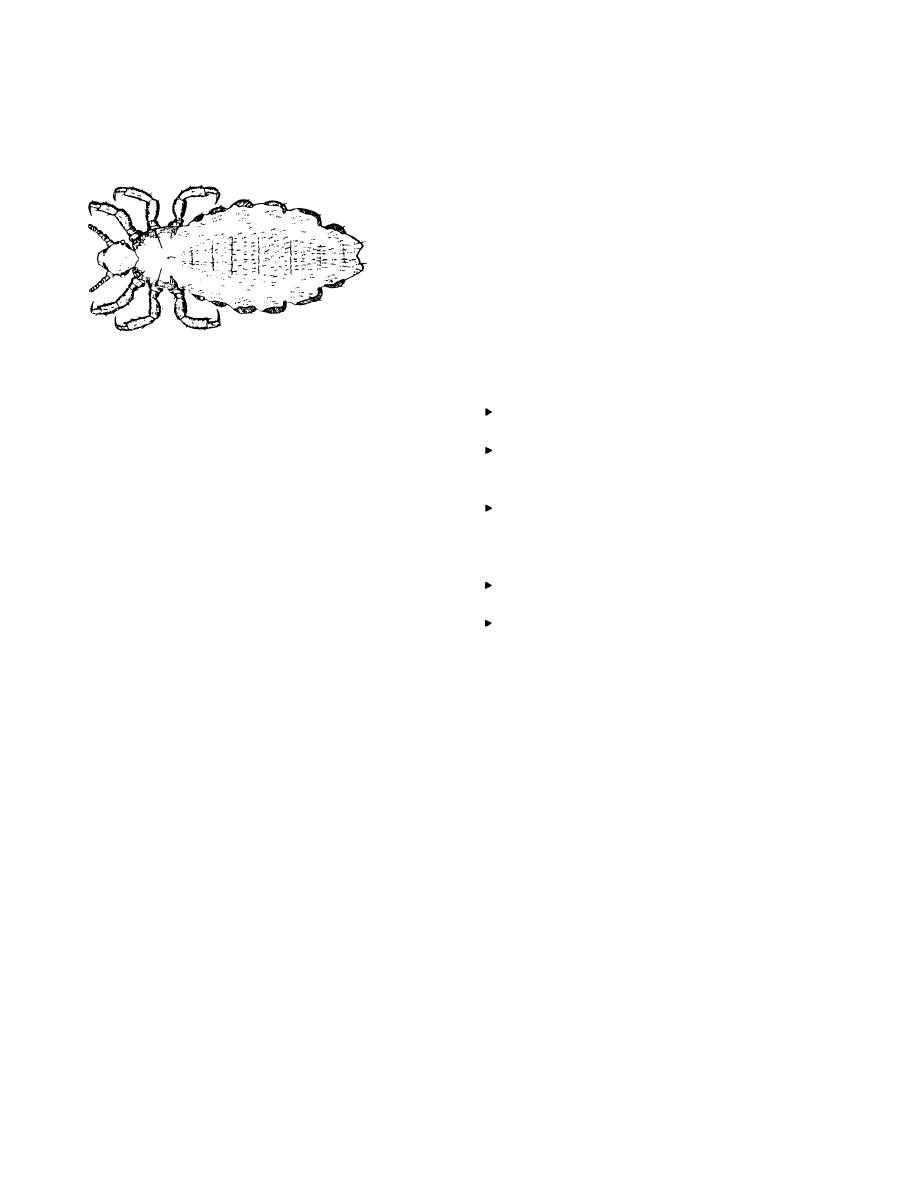

Custom Search
|
|

|
||
 eastern cities to infest the heads of Caucasian and
adolescents or adults). They scuttle about on the scalp
oriental children but they very seldom infest those of
between hairs with much more speed than expected of
black children.
a small, soft, wingless insect with slender hair
grasping claws on the end of blunt legs.
Head Louse Control
Several over-the-counter and prescription
preparations are used to eliminate louse infestations;
they are all equally effective when used according to
label directions. Prescription preparations are applied
only once and have a high probability of killing the
eggs as well as live lice. The preparations from
drugstores need to be used twice. The first application
kills all of the live lice. Viable nits hatch in 6-10 days
and the second application kills that population. These
lousicides are applied to wet hair and after a short
Close adaptation locks head lice into the human
waiting period they are shampooed out. Advise clients
scalp in several ways. First, louse claws grasp human
to
Treat all members of the family who
hair so firmly that they do not fall or wander out of it.
are infested at the same time.
Second, head lice suck blood by grasping the scalp
with tiny hooks that surround their mouth, and
Wash bedding and knit caps in hot
painlessly pierce the skin with slender stylets. [Head
water to be sure any nits on fallen hairs
lice feed several times a day but do not engorge
are killed.
themselves.] Most importantly, head lice neatly glue
Vacuum all surfaces where children lie
their eggs (called nits) to the hair shaft, always within
or play (including stuffed toys). [In day
l/4 inch of the scalp. The tiny, pearl-like eggs stick
care centers and kindergartens, napping
alongside the hair so tightly that they can be dislodged
mats should be wiped or vacuumed.]
only by being torn from the neat sleeve of biological
Clean rugs or simply quarantine them
glue by fingernails or a fine toothed comb. Nits found
for 10 days after vacuuming.
further away from the scalp than l/4 inch will have
Remember, do not apply pesticides to
already hatched; what is found is the empty shell
rooms, toys, or furniture surfaces.
which remains attached.
Decisions on the formulation of lousicide,
The spread of head lice is not well known, but
treatment of head infections from extensive
lice do not roam from child to child. Neither do they
infestations, and so forth, are decisions to be made by
wander onto coat collars or hats, since they are so
parents and physicians.
restricted to human hair and the scalp surface
Reported louse infestations of adolescents and
temperature of around 80F or a little more.
adults should be investigated by a physician; if live
Temperature preference and perhaps humidity is so
lice are not seen, the nits should be examined through
critical that lice die at elevated temperatures and from
a microscope to assure that they are not symptoms of
excess perspiration. Conversely at lower surface
scalp conditions.
temperatures (about 50F) lice become torpid and do
BODY LICE
not move or feed. A reasonable speculation is that
Pediculus humanus
head louse nymphs hatch from nits on hair snatched by
brushes and knit hats. The tiny nymphs then move
Head and body lice are indistinguishable in
toward the warmth of the next head covered by the cap
appearance and life cycle, however, their behavior is
or brushed by the brush. This normally limits
very different: Both suck blood, but body lice engorge
transmission to siblings that have their hair brushed
themselves, feeding to the point that their abdomens
with a "family brush" or children who use knit hats
become purple and distended. Body lice are easily
and brushes of friends. Louse infestations are often
reared on rabbit blood after a period of assimilation
discovered by school teachers who are watching for
but head lice can only be successfully reared on
the signs of itching heads, but classroom neighbors are
humans. Body lice harbor on clothes, hiding along
not as likely to be infested as are brothers and sisters
seams and moving to the body to engorge. They do
or close friends that sleep over and share brushes.
not deposit their eggs on body hair or head hair but on
Head lice have been shown by surveys in several large
clothing. While body louse epidemics are controlled on
Module Two, Chapter 4, Pg 12
|
 
|
|
 |
||